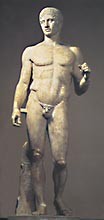|
Systematic study of the arts was not attempted until the 'humanist' movement of the 5th century B.C. Nevertheless, instances of judgments about aesthetics can be found in earlier periods. The weightiest of these are by Pythagoras. In the Pythagorean conception, qualitative difference, tonal scale, and the musical intervals were all bound up with the idea of harmony and mathematical reasoning. Anaxagoras, too, is credited with having written a book on perspective in painting.
In the 5th century there were several theoretical treatises 1) on literature and music and 2) on the plastic arts. Unfortunately nothing has come down to us either of the works on music by Laius from Hermione and by Damon of Athens, or by Sophocles 'On Dancing'. Polyclitus, we know, made reference to proportions in sculpture with his 'Canon'; Agatharchus wrote about scene-painting; and Parrhasius and Democritus wrote about painting. These works were probably pitched more at the level of theory of art criticism than that of aesthetics; but without them the level of philosophical generalization that we find in the aesthetic attitudes of Plato and Aristotle would hardly have been possible. |
 |




